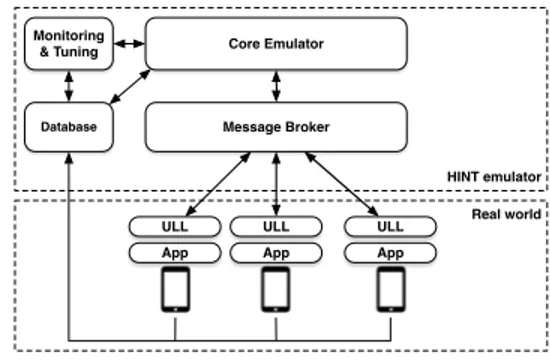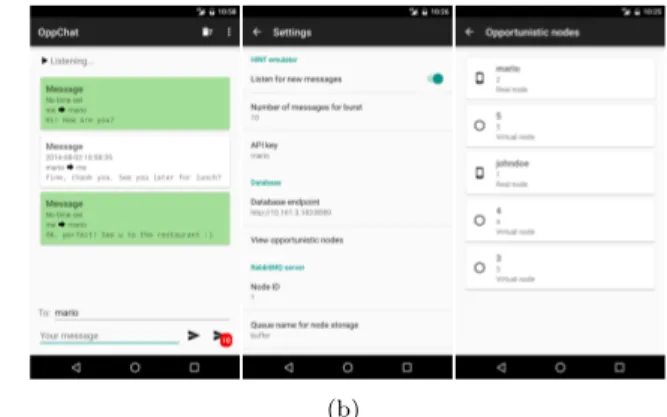HAL Id: hal-02545999
https://hal.archives-ouvertes.fr/hal-02545999
Submitted on 22 Apr 2020
HAL is a multi-disciplinary open access
archive for the deposit and dissemination of
sci-entific research documents, whether they are
pub-lished or not. The documents may come from
teaching and research institutions in France or
abroad, or from public or private research centers.
L’archive ouverte pluridisciplinaire HAL, est
destinée au dépôt et à la diffusion de documents
scientifiques de niveau recherche, publiés ou non,
émanant des établissements d’enseignement et de
recherche français ou étrangers, des laboratoires
publics ou privés.
Using the HINT network emulator to develop
opportunistic applications
Antoine Auger, Gwilherm Baudic, Victor Ramiro, Emmanuel Lochin
To cite this version:
Antoine Auger, Gwilherm Baudic, Victor Ramiro, Emmanuel Lochin. Using the HINT network
emu-lator to develop opportunistic applications. the Eleventh ACM Workshop, Oct 2016, New York City,
United States. pp.35-36, �10.1145/2979683.2979699�. �hal-02545999�
Demo: Using the HINT Network Emulator to Develop
Opportunistic Applications
Antoine Auger, Gwilherm Baudic, Victor Ramiro, Emmanuel Lochin
Institut Supérieur de l’Aéronautique et de l’Espace (ISAE-SUPAERO)Université de Toulouse, 31055 Toulouse Cedex 4, France
{first.second}@isae.fr
ABSTRACT
In this work, we show how to use HINT, a real-time event-driven network emulator, to support the development pro-cess of opportunistic applications. In this demo, we use this emulator in conjunction with an example Android chat ap-plication to demonstrate its features.
Keywords
DTN, Emulation, Opportunistic networks, Architecture
1.
INTRODUCTION
Developers of applications running over opportunistic net-works, must not only deal with network characterization, but also with its impact on their application. Indeed, the complexity to evaluate the performance before a real world deployment is still an open issue.
Simulations help to gain insight in the network behav-ior [2, 3, 4], but they do not support real nodes, and typ-ically focus on network performance. Testbeds provide an almost real world feedback, but they are heavy and expen-sive to deploy. Currently there is no tool to help during the development process.
For this purpose, we propose HINT [1], a new hybrid em-ulation system for opportunistic networks, where nodes can be either real or virtual. Thanks to the support of Android devices as real nodes, it aims to help developers to conceive and test their opportunistic applications before moving to a real-world deployment.
In this demo, we show the development process of an op-portunistic application from development, test and perfor-mance evaluation perpectives. We show three different use cases for HINT: How to connect an application to an op-portunistic network, to test the application using the HINT emulator and finally to easily test different application sce-narios using the HINT monitoring system.
ACM ISBN 978-1-4503-2138-9. DOI:10.1145/1235
2.
HINT IN A NUTSHELL
In this section, we present the main details of the HINT architecture. HINT is a lightweight real-time event-driven emulator meant to fit into existing development environ-ments.
We define two interaction levels: the real world and the emulated world. In the real world, real nodes (i.e., Android mobile devices) run applications to be tested, while in the emulated world, both virtual nodes and real nodes interact in an opportunistic way. HINT defines nodes’ interaction be-tween all nodes at the emulated world, and applies changes in real-time according to contact opportunities. Real nodes can only communicate with the emulator (at the real world level), and not directly with each other. Hence, we en-sure that all connections go through HINT. Several network topologies can be drawn, according to the considered user scenario. Core Emulator Message Broker Monitoring & Tuning Database Real world HINT emulator App ULL App ULL App ULL
Figure 1: HINT network emulator architecture.
Figure 1 shows the main architecture. HINT is organized around the event-driven Core Emulator which runs the ex-periment scenario. Events define contact or intercontact durations and message management (creation, replication, forwarding, etc.). The Message Broker allows the commu-nication between each pair of nodes (real or virtual). It is used to represent node buffers and store messages. The User Link Layer is deployed on the real nodes as an Android ser-vice, to act as an abstraction layer between the emulator and the application. This makes HINT transparent to the appli-cation being tested. A Cross-layer Monitoring and Tuning system, implemented with a web interface, allows to follow the experiment in real-time and adjust parameters. Finally, a Database stores the characteristics of each node, along with the data required for the Monitoring system.
(a) (b)
Figure 2: A set of screenshots: (a) shows the web-based monitoring interface for HINT; (b) shows different views of the OppChat Android application.
3.
DEMO OVERVIEW
We now present the validation of the HINT emulator. Our scenario defines an opportunistic network of 50 nodes, split into 47 virtual nodes and 3 real nodes (Android devices). Pairwise contact and intercontact events are generated ac-cording to an homogeneous exponential distribution. All nodes route their messages using the forward protocol. Real nodes both deploy an opportunistic chat application and the HINT user link layer. The chat application can either broadcast messages to all connected nodes or deliver a pri-vate message to a specific node.
HINT application development: first, we demonstrate how to bind an existing application to the HINT emulator using the User Link Layer package. We develop OppChat, an Android opportunistic chat application. OppChat takes advantage of our User Link Layer service to seamlessly ex-change messages with other nodes through the HINT Core Emulator. Indeed, to send a chat message the application just needs to call the appropriate User Link Layer method. To receive messages, the application declares a standard Broadcast Receiver subclass that appropriately filters and handles incoming chat messages. When messages are for-warded to a node within the HINT Core Emulator, they are placed into Message Broker queues. Then, the broker fires a notification to the User Link Layer of the corresponding real node. Finally, the message is consumed from the broker by the User Link Layer and passed to the application by means of a Broadcast Intent to be finally displayed in OppChat.
HINT validation: the goal of this experience is to test the correctness of the HINT emulated connections with both emulated and real nodes. We deploy OppChat on real nodes (see Figure 2b). When this chat application must broadcast one message to all other opportunistic nodes, one message is created for each node in the emulator. When a message is sent from OppChat, the User Link Layer transmits it to the broker using a TCP connection. We show that the network connection delay is negligible compared to the contact and intercontact durations tested. Messages are routed among nodes within HINT until their delivery to the final desti-nation where they are displayed at the chat log window. In this special validation, we can send messages between two or more real nodes connected to HINT. Since there is no direct connection between the real nodes but rather an emulated connection with the HINT Core Emulator, once a message is sent it will traverse the emulated opportunistic network
be-fore arrival to all other real nodes. This allows developers to test the interaction of the application on different scenarios of emulated opportunistic networks.
HINT monitoring: finally, we demonstrate the use of the HINT Monitoring system. HINT provides a real-time monitoring interface for different levels of granularity: met-rics for the whole emulated opportunistic network, pairwise-based metrics and a node status view. In this experiment, a real node sends a private message to another real node thanks to the OppChat application. We set nodes’ buffer size limit to 20 bytes and tail drop buffer policy. To show the impact on node’s buffer size and its drop ratio, we in-tentionally send “message bursts” (10 copies of the original message). We then monitor the global drop ratio, as well as the hop number distribution (see Figure 2a).
4.
CONCLUSION
In this demo, we presented the use of HINT to develop, test and monitor a simple opportunistic application. The aim of HINT is to help bridge network characterization and real application development. Differently from a simulator, our proposal is designed to handle both real and virtual nodes in the same setup. Compared to testbeds, our system has low hardware requirements (one computer and some An-droid devices) and may be easily deployed in development environments.
Acknowledgments. This research was supported in part by the French Ministry of Defense through financial support of the Direction G´en´erale de l’Armement (DGA).
5.
REFERENCES
[1] G. Baudic, A. Auger, V. Ramiro, and E. Lochin. Using emulation to validate applications on opportunistic networks. Available: http://arxiv.org/abs/1606.06925, June 2016.
[2] X. Chang. Network simulations with OPNET. In ACM WSC’99, 1999.
[3] T. R. Henderson, M. Lacage, G. F. Riley, C. Dowell, and J. Kopena. Network simulations with the ns-3 simulator. SIGCOMM demonstration, 14, 2008. [4] A. Ker¨anen, J. Ott, and T. K¨arkk¨ainen. The ONE
simulator for DTN protocol evaluation. In Proceedings of the 2nd international conference on simulation tools and techniques. ICST, 2009.

